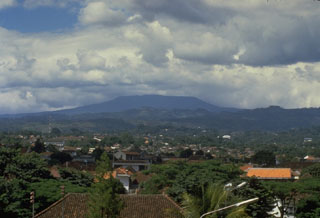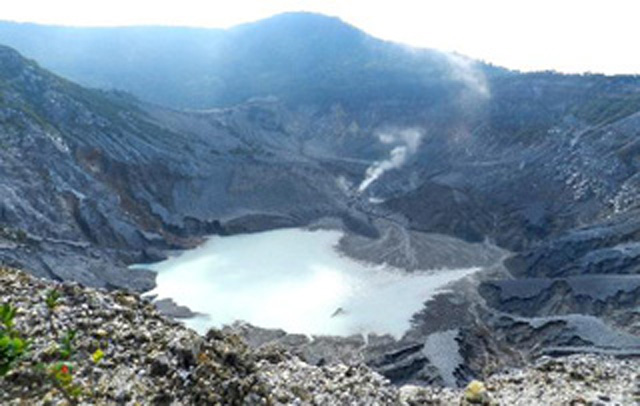Report on Tangkuban Parahu (Indonesia) — April 2015
Bulletin of the Global Volcanism Network, vol. 40, no. 4 (April 2015)
Managing Editor: Richard Wunderman.
Tangkuban Parahu (Indonesia) West Java volcano issues very small eruption in March 2013; months of tremor and few volcanic earthquakes
Please cite this report as:
Global Volcanism Program, 2015. Report on Tangkuban Parahu (Indonesia) (Wunderman, R., ed.). Bulletin of the Global Volcanism Network, 40:4. Smithsonian Institution. https://doi.org/10.5479/si.GVP.BGVN201504-263090
Tangkuban Parahu
Indonesia
6.77°S, 107.6°E; summit elev. 2084 m
All times are local (unless otherwise noted)
Tangkubanparahu (Tankuban Parahu) erupted multiple times during the interval of reporting from February 2013 through December 2014. The eruptions were from Ratu crater and of quite small size (highest reported plumes only rose to 100 m tall). The vent grew in size as a result of these eruptions, reaching in early March 2013 a diameter of 20 m. The small eruptions contained minor ash but did not emit a dome or lava flows and accordingly did not lead to thermal anomalies detected via the MODVOLC satellite-based infrared detection system (and this is the case going back to at least the year 2010).
In past reports during the past few decades, Tangkubanparahu has largely been quiet but with occasional tremor and volcanic earthquakes (eg., late August-October 2002, 12-19 April 2005, and August-September 2012; BGVN 27:09, 28:08, 30:12, and 37:11). The location of the volcano in Java is shown in figure 1 of BGVN 37:11.
According to the Center of Volcanology and Geological Hazard Mitigation (CVGHM, also known as Pusat Vulkanologi dan Mitigasi Bencana Geologi, PVMBG), tremor increased on 21 February 2013 and diffuse ash emissions rose from Ratu Crater. Based on the seismicity, visual observations, and temperature increases of the land around the crater, CVGHM raised the Alert Level to 2 (on a scale of 1-4) and visitors were reminded not to approach the crater within a radius of 1.5 km.
CVGHM reported that phreatic eruptions from Tangkubanparahu's Ratu Crater occurred on 28 February and during 4-6 March 2013, and generated ash plumes that rose up to 100 m above the crater.
A news report (kompas.com) quoted CVGHM as stating that the March explosion was much stronger than the one on 21 February 2013. The news report said that the 6 March eruption lasted for ~8 minutes. The Jakarta Post also said that the 6 March eruption lasted ~8 minutes and ejected ash about 30 m above Ratu Crater. The Jakarta Post reported that on 18 March, CVGHM lowered the Alert Level to 1 (normal) because of a significant decrease in the tremor frequency. The article also quoted CVGHM as stating that deformation, using a Global Positioning System (GPS) and Electronic Distance Measurement (EDM), found at one or more stations a decline in relative elevation from 6.84 cm to a few millimeters by 18 March. Deflation was again detected from 24 February through early March 2013, but was stable during 7-14 March 2013.
According to CVGHM, sulfur dioxide emissions increased to 5.3 metric tons per day (t/d) on 24 February 2013, decreased through 3 March 2013 to 2.1 t/d, and then increased again during 5-9 March 2013 to 4.9 t/d. CVGHM speculated that the increase was due to an enlargement of the eruptive vent, which had grown to a diameter of 20 m.
Gas emissions decreased abruptly on 10 March 2013 to 2.1 t/d and emission sounds stopped. On 4 March 2013, a new solfatara vent opened, but SO2 levels could not be measured on that day because of weather conditions.
On 5 October 2013, a phreatic eruption occurred, causing CVHGM to raise the Alert Level to 2. Figure 2 is an image of Ratu Crater.
CVGHM reported that during November-December 2014 white plumes rose up to 50 m above Ratu Crater. Deformation occurred and seismicity increased. On 31 December the Alert level rose to 2 (on a scale of 1-4), cautioning people to remain at least 1.5 km from the crater.
Seismicity. The CVGHM report discussing late 2014 features a plot of seismic data during December 2012 through December 2014, which the authors termed significant, the chief observation prompting a rise in alert level (to II).
Tremor was most prominent beginning mid-2013 to early March 2014. Both low-frequency and hybrid earthquakes were nearly absent except during a short sequence in late 2014 (each with over 100 earthquakes; see table below). Type-B earthquakes were common at levels from a few to ten events per 20-day interval, and like the low-frequency and hybrid earthquakes, peaked in latest December 2014 (~50 type-B events). Type-A earthquakes showed little or no tendency to cluster and remained below 5 events per 20 day interval and on many days they were absent.
Table 3 indicates the types and frequencies of seismic activity at Tangkubanparahu during selected, mostly active periods during 2013. Shallow volcanic earthquakes predominated during many of these periods. The number of tremor was high during the first week of March 2013, but significantly declined thereafter. The 25 September 2013-5 October 2013 period contained somewhat elevated seismicity, yet apparently lacked significant eruptive activity. Note the emergence of 513 low-frequency earthquakes during 1-31 December 2014 (lower right). That data is in the same year-end report (issued in early 2014 and written in Indonesian) and is also noteworthy in terms of the plot of distance (EDM) data to various reflectors around the crater during the entire year of 2013.
Table 3. A compilation of earthquake counts and tremor durations recorded at Tangkubanparahu for selected periods during 2012-2014. Definitions: -- signifies no data (presumably no episodes); VA, volcanic type-A earthquake; VB, type B (shallow volcanic earthquake); TJ, deep tectonic earthquake; BQ, an earthquake indicative of emissions; and TL, local tectonic earthquake. Courtesy of CVGHM.
| Date (day or days) | VA | VB | TJ | BQ | TL | Tremor (amplitude, duration) | Other data & kinds of earthquakes (EQs) |
| 22 Jun 2012-28 Feb 2013 | 5 | 20 | 2 | 4 | 2 | 13 (2-45 mm, 3-92 min) | Phreatic eruption on 21 Feb |
| 1-6 Mar 2013 | 14 | 32 | 2 | 41 | -- | 19 (2-30 mm, 3-92 min) | 4 eruptions during period (6-35 mm, 7-13 min) |
| 7-13 Mar 2013 | 2 | 25 | 4 | 6 | -- | 2 | No tremor 8-18 Mar |
| 14-18 Mar 2013 | 1 | 14 | 5 | -- | -- | 0 | -- |
| 25-30 Sep 2013 | 6 | 26 | 8 | -- | 1 | 1 | -- |
| 1-5 Oct 2013 | -- | 13 | 7 | 1 | -- | 2 | -- |
| 21 Oct 2013 | -- | 4 | 1 | -- | -- | Continuous (amp. 1-3 mm, 12 hr) | -- |
| 22 Oct 2013 | -- | 13 | 1 | -- | -- | 1 | 1 Low freq earthquake |
| 23 Oct 2013 | 1 | 12 | 7 | 1 | -- | 3 | 1 Low freq earthquake |
| 24 Oct 2013 | 2 | 9 | 2 | 5 | -- | -- | -- |
| 25 Oct 2013 | -- | 6 | 4 | 1 | -- | 2 (0.5-1 mm, less than 2 min) | -- |
| 26 Oct 2013 | 1 | 7 | 4 | -- | -- | 1 (0.5-1 mm, less than 2 min) | -- |
| 27 Oct 2013 (partial) | -- | 1 | 1 | -- | -- | -- | -- |
| 1-31 Oct 2014 | 9 | 126 | 45 | 50 | 12 | 10 cases | 6 low-frequency EQs, |
| 1-30 Nov | 6 | 146 | 35 | 185 | 6 | -- | 8 low-frequency EQs; 14 tornillo EQs |
| 1-31 Dec 2014 | 10 | 352 | 41 | 22 | 6 | -- | 1 tornillo EQ; 513 low-frequency EQs |
Geological Summary. Gunung Tangkuban Parahu is a broad stratovolcano overlooking Indonesia's former capital city of Bandung. The volcano was constructed within the 6 x 8 km Pleistocene Sunda caldera, which formed about 190,000 years ago. The volcano's low profile is the subject of legends referring to the mountain of the "upturned boat." The Sunda caldera rim forms a prominent ridge on the western side; elsewhere the rim is largely buried by deposits of the current volcano. The dominantly small phreatic eruptions recorded since the 19th century have originated from several nested craters within an elliptical 1 x 1.5 km summit depression.
Information Contacts: Center of Volcanology and Geological Hazard Mitigation (CVGHM) (URL: http:proxy.vsi.esdm.go.id/index.php); kompas.com (URL: kompas.com); and The Jakarta Post (URL: http://www.thejakartapost.com/).


